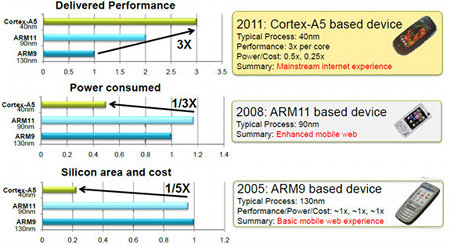Navigation SoCs will adopt ARM Cortex cores
Jan 26, 2011 — by LinuxDevices Staff — from the LinuxDevices Archive — 13 viewsCSR plc announced a “major licensing agreement” with ARM that will result in the former's GPS receivers being integrated with the latter's IP (intellectual property). The “location-aware” SoC (system on chip) platforms will include application processors with Cortex-A5 and Cortex-A9 cores, according to the companies.
Formerly known as Cambridge Silicon Radio, CSR plc acquired SiRF — known for the wide adoption of its GPS platforms by PND (personal navigation device) and smartphone manufacturers — in 2009. At that time, SiRF had already produced several SoCs integrating GPS receivers with ARM cores: the SiRFprima and the SiRFatlasIV.
Under CSR's aegis, the SiRFatlasV was introduced last May, again using an ARM1136GH-S computing core, but now with a faster 664MHz clock speed. Comparing the V and IV, CSR said the newer device reduced overall power consumption by ten percent and integrated a number of previously external components.
As with previous SiRF SoCs, the SiRFatlasV was said to use a "high-sensitivity" engine that supports both American GPS and European Galileo satellites. Employing proprietary power management and orbital (ephemeris) prediction algorithms, "SiRFAlwaysFix" technology delivers quick time to first fix results without having to stay at full power, the company added.
Now, CSR is licensing ARM's Cortex-A5 and Cortex-A9 for its future SoCs. While the higher-end Cortex-A9 has so far been the most popular, A5 and A9 are both application-compatible, support ARM's MPCore interconnect technology, and include the Neon multimedia processing engine.
When it announced the Cortex-A5 in October 2009, ARM suggested that a uniprocessor version could provide a migration path for licensees of the venerable and ubiquitous ARMv5-based ARM926EJ-S core. The A5 was also billed as successor to the faster, ARMv6-based ARM1176JZ-S.

The Cortex-A5 is positioned to replace ARM9 and ARM11
Source: ARM slide from 2009
(Click to enlarge)
In announcing the latest licensing agreement with ARM, CSR appeared to suggest that its Cortex implementations will be headed for PNDs and in-vehicle systems rather than smartphones. A particular focus will be "new, emerging location-aware consumer device markets, especially in the fast growing economies of the Brazil, Russia, India and China (BRIC) countries," the company said in its release.
Babak Bastani, vice president of global chip design for CSR, stated, "The scalability of both processors provides the flexibility for us to optimize the performance for each application within a low-power footprint. Combining our state of the art location and connectivity expertise with two software-compatible processors based on the standard ARM architecture will enable us to reduce our development costs while delivering leading edge products to market in a timely manner."
Eric Schorn, vice president of marketing for ARM's processor division, stated, "This latest agreement with a global leader in wireless connectivity and location markets demonstrates the continued market momentum for the ARM Cortex-A series processors and ARM MPCore technology."
This article was originally published on LinuxDevices.com and has been donated to the open source community by QuinStreet Inc. Please visit LinuxToday.com for up-to-date news and articles about Linux and open source.